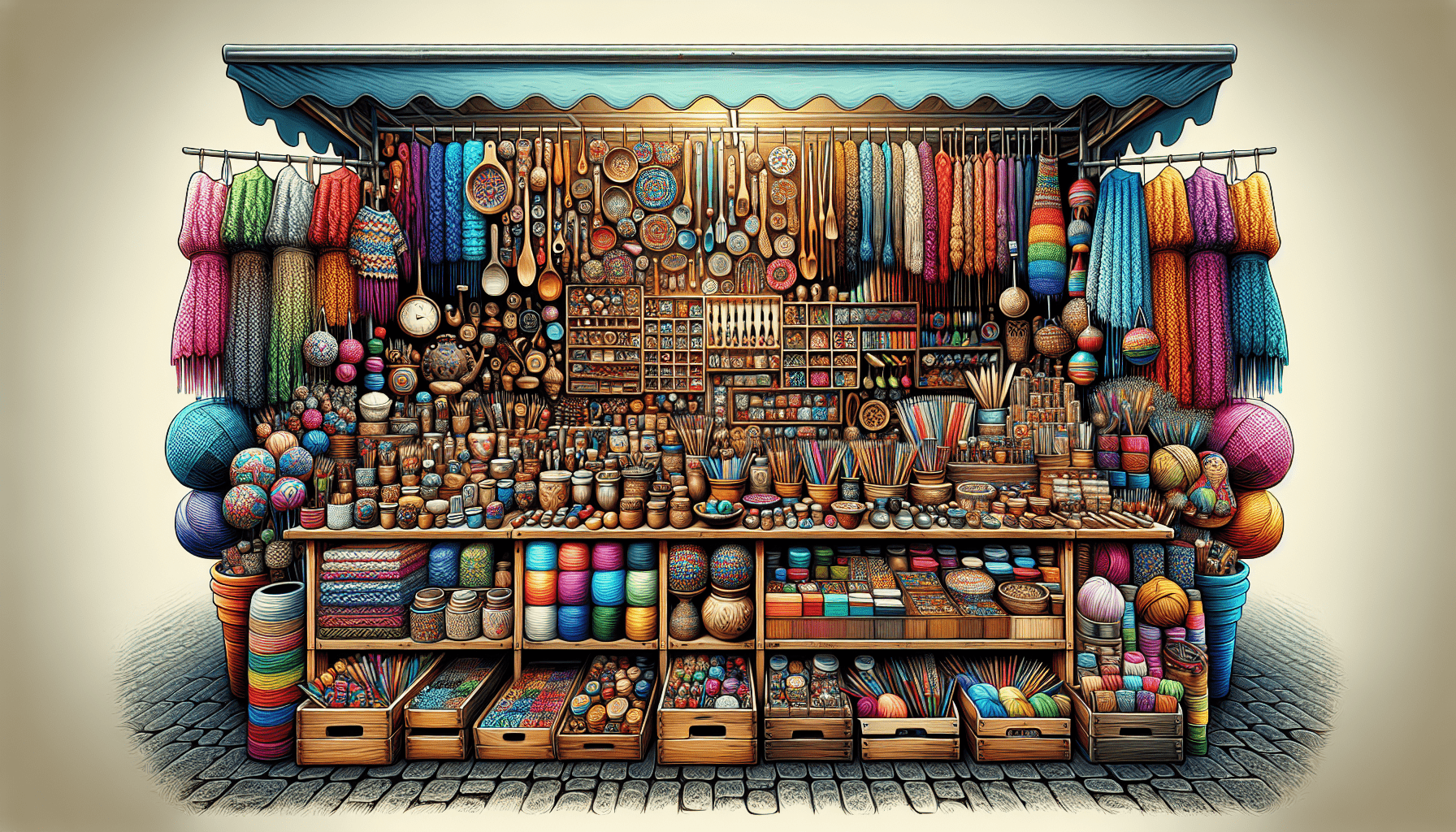Craft fairs are a treasure trove of unique and handcrafted goodies, but have you ever wondered what items are the top sellers in these bustling events? From intricately designed jewelry to beautifully knitted scarves, there seems to be an endless array of options for visitors to choose from. This article explores the fascinating world of craft fairs and uncovers the most sought-after items that fly off the shelves. So, whether you’re an avid craft fair attendee or a talented artisan yourself, read on to discover what sells like hotcakes at these creative gatherings. Craft fairs are a hub of creativity and ingenuity, where artisans and makers showcase their unique creations. From handmade jewelry to personalized items, there is an array of products that capture the attention of craft fair shoppers. In this article, we will explore the popular items that tend to sell the most at craft fairs, the important factors to consider when participating in a craft fair, and some valuable tips for success.
Popular Items
At craft fairs, certain types of products consistently attract a significant number of buyers. Understanding these popular items can help craft fair participants make informed decisions when planning their offerings. Handmade jewelry is one such category that never fails to entice customers. Whether it’s delicate necklaces, stylish earrings, or statement bracelets, the allure of handmade jewelry lies in its uniqueness and craftsmanship.
Another popular category at craft fairs is handmade clothing and accessories. From cozy knitted scarves to fashionable handbags, shoppers are drawn to the uniqueness and personal touch that these items offer. Similarly, home decor items, including handmade ceramics, textiles, and wall art, are highly sought after. These pieces allow individuals to elevate their living spaces with one-of-a-kind, artisanal creations.
Candles and soap are also in high demand at craft fairs. People appreciate the soothing scents and natural ingredients used in handmade candles and soaps. Craft fair attendees often find delight in browsing through tables adorned with beautiful artwork. Whether it’s paintings, drawings, or mixed media pieces, artwork has a way of captivating the hearts of customers.
Handmade toys and games for children are another category that sells well at craft fairs. Parents are constantly looking for unique, educational toys and games that foster creativity and imagination in their little ones. Moreover, personalized items such as engraved jewelry or monogrammed accessories resonate with customers who seek to add a special touch to their belongings.
Holiday and seasonal items hold a special place in the hearts of craft fair shoppers. From Christmas ornaments to Halloween decorations, these items create a sense of joy and excitement. Food and beverage products, such as homemade jams, artisanal chocolates, and handcrafted drinks, also garner attention at craft fairs. People appreciate the opportunity to savor and indulge in locally made delicacies.
Lastly, pet products cater to the needs and desires of animal lovers. Handmade pet accessories, toys, and treats allow pet owners to pamper their furry friends in a unique and thoughtful way. These categories represent just a glimpse into the diverse range of products on offer at craft fairs.
Factors to Consider
While understanding the popular items at craft fairs is essential, considering various factors is equally important. This ensures that craft fair participants make informed decisions that align with their goals and values. Trends and themes play a significant role in attracting customers. Stay up-to-date with emerging trends and incorporate them into your creations, keeping them fresh and relevant.
Quality and craftsmanship are crucial factors that can make or break sales. Craft fair shoppers appreciate attention to detail and the use of high-quality materials. Investing time and effort into perfecting your craft will undoubtedly pay off in the long run. However, it is important to strike a balance between quality and pricing.
Speaking of pricing, it is essential to determine fair and competitive prices for your products. Researching the market and evaluating the value of materials and time spent can aid in setting the right price points. Additionally, consider offering various price ranges to cater to a wider range of customers.
Presentation and packaging are often overlooked but can make a significant difference. Thoughtfully designed displays and attractive packaging can attract more customers and leave a lasting impression. Grab the attention of potential buyers with eye-catching visuals and a well-organized booth setup.
Understanding your target audience is key to successful sales at craft fairs. Tailor your products and marketing efforts to resonate with your ideal customer. Research the demographics and preferences of craft fair attendees to curate products that align with their tastes.
Competition is a reality at craft fairs. Stand out from the crowd by finding your unique selling point and differentiating your offerings. Offer something distinct and exclusive that sets you apart from other vendors.
Promotion and marketing play a vital role in attracting customers to your booth. Utilize social media platforms, word-of-mouth marketing, and traditional advertising methods to create buzz before the event. Engage with your potential customer base, build excitement, and showcase sneak peeks of what you will be offering at the craft fair.
Location and timing are strategic factors that can impact your sales. Research the target audience in the area where the craft fair will be held and consider participating in events that align with your niche. Additionally, timing plays a crucial role, as attending craft fairs during peak shopping seasons or in conjunction with local celebrations can maximize your potential sales.
Customer preferences should guide your product offerings. Pay attention to feedback and reviews from past customers to identify areas of improvement and refine your products accordingly. Engage with customers during craft fairs and actively seek feedback to continuously enhance your offerings.
Tips for Success
Craft fairs can be a rewarding experience when approached with a well-thought-out plan. Here are some valuable tips to help you succeed:
-
Variety and Range of Products: Offer a diverse range of products to cater to different customer preferences and increase sales potential.
-
Display and Visual Appeal: Create an attractive booth setup that catches the eye and encourages customers to explore your products. Pay attention to aesthetics and utilize props or decorative elements that enhance your overall presentation.
-
Engaging and Approachable Booth Setup: Make customers feel welcome and comfortable in your booth. Create a warm and inviting atmosphere where they can easily browse and interact with your products.
-
Demonstrations and Workshops: Consider hosting live demonstrations or workshops to engage with customers and showcase your creative process. This interactive approach can attract more attention and establish a connection with potential buyers.
-
Personalization and Customization Options: Offer customers the opportunity to personalize or customize certain items. This adds a unique touch and creates a sense of exclusivity, making your products more appealing to buyers.
-
Accepting Various Payment Methods: Ensure you have multiple payment options available, such as cash, credit cards, and mobile payments, to accommodate different customer preferences and increase sales.
-
Building an Online Presence: Establish an online presence through social media platforms and a website. Share updates, behind-the-scenes content, and sneak peeks of your creations to build anticipation and attract a broader customer base.
-
Forming Connections and Networks: Network with fellow artisans and makers to learn from their experiences and gain valuable insights. Building connections within the crafting community can open doors to collaborations and shared resources.
-
Researching and Learning from Others: Stay informed about industry trends, techniques, and best practices. Attend workshops, webinars, and seminars to expand your knowledge and continuously improve your craft.
-
Continuous Improvement: Embrace the mindset of continuous improvement. Seek feedback, analyze your sales data, and reflect on your craft fair experiences to identify areas for growth and refinement.
In conclusion, understanding the popular items at craft fairs, considering crucial factors, and implementing effective strategies can lead to a successful craft fair experience. Remember to stay true to your vision and passion, and let your creativity shine through your unique creations. Craft fairs serve as a platform for artisans and makers to share their talents with the world, and by utilizing the tips mentioned above, you can thrive in this vibrant and dynamic environment. So, embrace the opportunity, connect with customers, and make your mark in the world of craft fairs!



